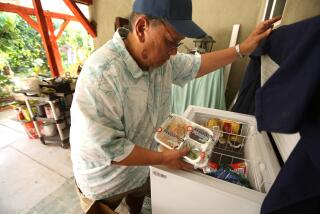News, Tips & Bargains : Brown Bagging It, American-Style
- Share via
In a move to trim costs to counter competition from low-cost discount airlines, American Airlines has launched a brown bag “Bistro” meal service on short flights.
Under the new service, passengers pick up their breakfasts or lunches from coolers set up by the boarding gate. A typical Bistro breakfast includes a muffin, banana, yogurt and juice. Lunch might be a sandwich, chips and a cookie. Beverage service continues to be provided on the flights, American said.
Spokesman Joe Crawley said the new service prevents waste from meals that go uneaten and cuts down on labor. American serves 190,000 meals a day, Crawley said, and “every time you handle 190,000 of something, that’s a lot of manpower.”
“The shorter flights are where we find the wastage,” he said, noting passengers tend to eat meals on longer routes.
Houston and Washington’s National Airport were the first to use the service on American flights of 2 to 2 1/2 hours, and American said the service was extended to Baltimore and New Orleans in the past two weeks. It will debut in Dallas on April 1 and will spread throughout most of its U.S. system this year.
First-class passengers or those who have requested special meals will continue to get meal service at their seats.
Hepatitis Drug Now Available
Gamma globulin, used to protect travelers against hepatitis A, is in short supply as a result of demands by the military in the Mideast, Somalia and Haiti--and will probably remain so for the next several months. But those with departure dates several weeks away can use the new hepatitis A vaccine (Havrix) for protection, according to the federal Centers for Disease Control and Prevention.
Until very recently, gamma globulin was the only way to guard against hepatitis A, a highly contagious virus that attacks the liver and can result in death. But late last month, the Food and Drug Administration approved use of Havrix, and a spokeswoman for its manufacturer, SmithKline Beecham, said the drug is available.
While CDC guidelines for vaccine use have not yet been established, an agency spokesman said it will probably be recommended for travelers who are not departing immediately since it may take as long as a month before the drug produces maximum immunity. It is, however, expected to offer protection for up to several years. Travelers leaving the United States immediately will be advised to take gamma globulin shots. But since gamma globulin offers only short-term protection--an estimated 3-5 months--some travelers might use a combination of both.
CDC recommends travelers seek hepatitis A protection if going to Mexico, parts of the Caribbean, South and Central America, Africa, Asia (except Japan), the Mediterranean basin, Eastern Europe and the Mideast.
More to Read
Sign up for The Wild
We’ll help you find the best places to hike, bike and run, as well as the perfect silent spots for meditation and yoga.
You may occasionally receive promotional content from the Los Angeles Times.






